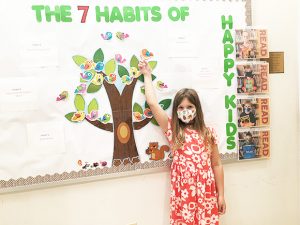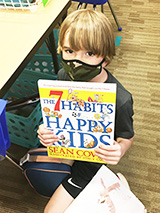by Andrew Blair
Under Samantha Shoop’s classroom instruction and guidance at Riverside, third and fourth graders in her classroom are developing educationally as well as learning about self-improvement and internal development.
 That’s because Mrs. Shoop integrates ‘The 7 Habits of Highly Effective People,’ the runaway bestseller authored by Stephen Covey about personal effectiveness, into core subject matter.
That’s because Mrs. Shoop integrates ‘The 7 Habits of Highly Effective People,’ the runaway bestseller authored by Stephen Covey about personal effectiveness, into core subject matter.
By studying the ‘7 Habits’ and its accompanying bottom-up tree and traits model—1. Be Proactive, 2. Begin With the End in Mind, 3. Put First Things First, 4. Think Win-Win, 5. Seek First to Understand, Then to be Understood, 6. Synergize, 7. Sharpen the Saw—Riverside kids are gathering knowledge and gleaning the value of developing character traits and helping others.
The benefits are numerous, according to Mrs. Shoop, who is expertly trained in the ‘7 Habits’ approach. She notes that the habits have an overarching touchpoint to core subject matters and pertains to many areas of leadership, including being a good listener, making smart choices, sharpening one’s vocabulary and learning how to handle conflict, to name just a few areas of self-awareness.
“It fits well with our population. Students are encouraged to demonstrate what good leadership looks like here,” says Mrs. Shoop, who is complementing her instruction by using ‘The 7 Habits of Happy Kids,’ written by Stephen’s son, Sean Covey. “Everyone I have ever taught at Riverside has gravitated toward the program. They are at a good age to learn it and start using it.”
 There are many benefits of the teaching approach, including facilitating student growth by using creative strategies to teach and drive home each habit. This is particularly applicable to kids with dyslexia that comprise Riverside’s 81-person student population—studies have shown that individuals with dyslexia tend to be more creative and look at things differently than others.
There are many benefits of the teaching approach, including facilitating student growth by using creative strategies to teach and drive home each habit. This is particularly applicable to kids with dyslexia that comprise Riverside’s 81-person student population—studies have shown that individuals with dyslexia tend to be more creative and look at things differently than others.
“They internalize the habits and discover how to integrate the habits into their lives such as community and serving others,” Mrs. Shoop says.
In their fundamental form, the first three habits entail ‘working on you,’ Nos. 4-6 deal with helping others and No. 7 is ‘taking care of yourself.’ One of the goals is to develop well-rounded citizens of the world who will contribute to society on a consistent basis.
Mrs. Shoop says she started weaving the ‘7 Habits’ concepts into her classroom instruction about 10 years ago and since, the feedback from students, parents and loved ones has been overwhelmingly positive. And let’s face it: She picked a good time to ingrain ideals of respect, connectedness and understanding given the dynamics of the world today.
“Sean thought, ‘If these habits are good for adults, I bet they are good for kid, too’—and they are,” underscores Mrs. Shoop, who has taught for 26 years. “It’s just a really cool thing to share with kids.”
![]()
Author Andrew Blair is communications and marketing coordinator at Riverside School.
